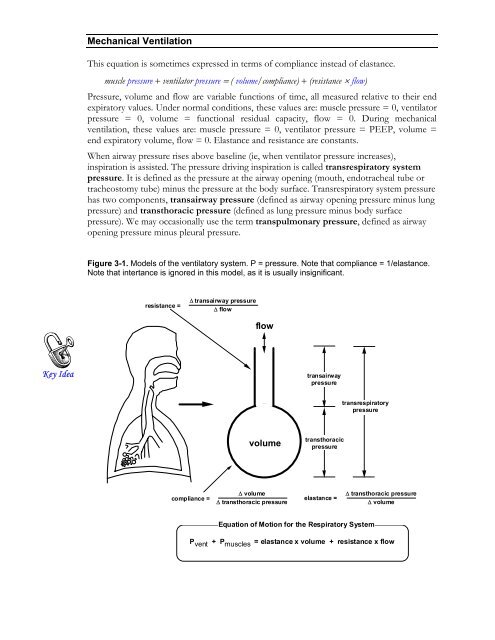Dräger Instructional CD: Mechanical Ventilation - VentWorld
Dräger Instructional CD: Mechanical Ventilation - VentWorld
Dräger Instructional CD: Mechanical Ventilation - VentWorld
Create successful ePaper yourself
Turn your PDF publications into a flip-book with our unique Google optimized e-Paper software.
Key Idea<br />
<strong>Mechanical</strong> <strong>Ventilation</strong><br />
This equation is sometimes expressed in terms of compliance instead of elastance.<br />
muscle pressure + ventilator pressure = ( volume/compliance) + (resistance × flow)<br />
Pressure, volume and flow are variable functions of time, all measured relative to their end<br />
expiratory values. Under normal conditions, these values are: muscle pressure = 0, ventilator<br />
pressure = 0, volume = functional residual capacity, flow = 0. During mechanical<br />
ventilation, these values are: muscle pressure = 0, ventilator pressure = PEEP, volume =<br />
end expiratory volume, flow = 0. Elastance and resistance are constants.<br />
When airway pressure rises above baseline (ie, when ventilator pressure increases),<br />
inspiration is assisted. The pressure driving inspiration is called transrespiratory system<br />
pressure. It is defined as the pressure at the airway opening (mouth, endotracheal tube or<br />
tracheostomy tube) minus the pressure at the body surface. Transrespiratory system pressure<br />
has two components, transairway pressure (defined as airway opening pressure minus lung<br />
pressure) and transthoracic pressure (defined as lung pressure minus body surface<br />
pressure). We may occasionally use the term transpulmonary pressure, defined as airway<br />
opening pressure minus pleural pressure.<br />
Figure 3-1. Models of the ventilatory system. P = pressure. Note that compliance = 1/elastance.<br />
Note that intertance is ignored in this model, as it is usually insignificant.<br />
resistance =<br />
∆ transairway pressure<br />
∆ flow<br />
compliance =<br />
flow<br />
volume<br />
∆ volume<br />
∆ transthoracic pressure<br />
transairway<br />
pressure<br />
transthoracic<br />
pressure<br />
elastance =<br />
transrespiratory<br />
pressure<br />
Equation of Motion for the Respiratory System<br />
∆ transthoracic pressure<br />
∆ volume<br />
P vent + P muscles = elastance x volume + resistance x flow


